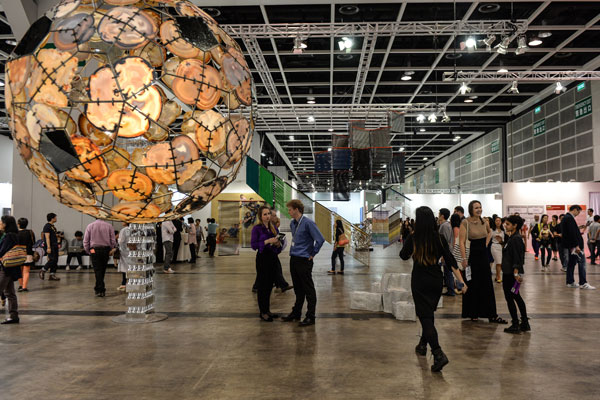Hong Kong, being a highly capitalized metropolitan, everything is about money making Therefore the city used to be named as “cultural desert (2014).” However, in recent years, art fairs and events boomed in Hong Kong. Besides that, there has been also a rapid growth in the number of visitors to art fairs.
From zero art show in a year to 5 in a month
Back to 2003, according to Lee Kit, a Hong
Kong artist interviewed by Sanchez C. (2013), there was no art fairs at all in
Hong Kong. Ten years later, in 2013, there were 7 local and international art
shows just in May (Wong A., 2013). One of the biggest art fairs is Art Basel. Founded by 3
Basel art gallerists, the show’s objective is “to provide a platform for
artists, gallerists and collectors” (Art Basel, n.d.), in other words, it’s
about art selling. The fair attracts numerous of visitors. In 2008, the year of
the first edition of the fair was held, it recorded almost 20,000 visitors. In
2013, the show recorded more than 60,000 visitors (Art HKs, n.d.). Why is there
such as drastic change and why would people like to attend art fairs?
 |
| Art Basel Hong Kong 2013 (Lee C., 2013) |
Education, lifestyle and appreciation
A research paper “Strategic Planning forthe City's Art Systems & Infrastructures “written by Zhou A. Y. (2013)
stated that resulting from a more educated society, “people have more developed
tastes for complex goods that perhaps reflect a culture, lifestyle, ideology,
or simply an intuitive aesthetic preference.” And therefore this popularizes
contemporary art collection and nurture the contemporary art market.
The view by Jeff Chang, an American
journalist and cultural critic al also somehow resonances Zhou’s point of view:
“Perhaps it is this wealth of ideas, opinions, and innovations found in
contemporary art that captures the public's attention and inspires a deeper
interest in the human condition.” (Zhou A. Y.,2013). This also well implies the
reason why besides of art collectors, the art fairs also attracts numerous of
visitors.
A more educated society
According to a report done by the
University Grants Committee (n.d.) under Hong Kong government, the higher
education has existed in Hong Kong for a century. From a chart in the
report shown below, the growth of number of people receiving higher education with support
by the government remained steady throughout 60’s to mid-80’s. The rapid growth
from the 90’s was due to HK government’s decision to increase the amount of
citizen having access to higher education in 1989.
Increased awareness to art
Apart from a more educated society, the
Hong Kong government’s policy in arts and culture also contribute to the
drastic change of the art scene in Hong Kong and enhance people’s awareness to
art (“From cultural desert”, 2014). In 2008, Hong Kong government kicked-off
the West Kowloon Cultural District project. The government’s ambition is to
make the district become “one of the largest cultural projects in the world,
blending art, education and open space.” (WKCD, n.d.).
 |
| The blue print of West Kowloon Cultural District. (HKIA, n.d.) |
PESTED analysis
It is quite obvious economic, social and political factors are the major forces that fuel the trend of arty shows going.
As Zhou A. Y. (2013) stated in her research paper, “art follows wealth”. The shift of international art community’s focus from the West to the East is mainly due to the economic growth of the East, or to be more precise, China. Buying art becomes a popular investment among the wealthy people. Art piece is luxury and is scarce because painting is unique and artists create very few, and so the return of investment is very promising.
Socially, more educated society has the ability to have a better understanding and appreciation of art.
Moreover,
the Hong Kong government’s arts and cultural policy also fuels the trend. Apart
from building one of the world’s largest cultural districts, the government
also put a lot of resources in arts and creative sector, including education,
infrastructure (Hong Kong Economic and Trade Office, New York, 2014) and support
to creative industry to develop the art and cultural market. (The Hong KongAssociation & Society, n.d.) All these stimulates the society’s awareness to
arts.


No comments:
Post a Comment